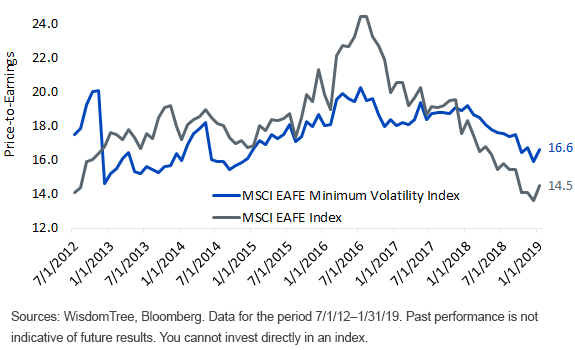The Minimum-Volatility Phenomenon



Exchange-traded fund (ETF) flows can be a good indicator of investor sentiment.
So far this year, sentiment toward developed international equities has been tempered—of the top 30 flow gatherers, none are focused on this segment of the market.1
But in developed markets broadly, both the U.S. and internationally, there has been significant movement into funds that target minimum volatility.
With so much demand for holdings that exhibit lower historical volatility, what exactly are the characteristics of these stocks?
Let’s focus on the developed international universe, where the most compelling case for that market seems to come down to favorable valuations.
Watch the Price Tag
Basic finance theory tells us that a riskier basket of stocks should command a greater equity risk premium than a less volatile basket. Thus, it makes sense that a minimum volatility index would trade at a premium to the broader market.
We can test this theory by looking at the valuations of the MSCI EAFE Index and the MSCI EAFE Minimum Volatility (USD) Index. Going back to 2012, the valuation gap between the two indexes has oscillated between premium and discount. Oddly enough, investors have often gotten away with not paying a premium for lower-vol stocks.
Why? In part because those stocks have at times been discounted since they are over-weight in sectors with lower growth expectations, such as Utilities and Real Estate.
Today’s nearly 15% multiple premium for the min-vol index is near the most expensive valuation gap over the past five years. At these elevated valuations, investors modeling long-term returns based on this min-vol index need to dampen return expectations relative to the broader index.
Developed International Price-to-Earnings Over Time

Looking for Quality?
Min-vol indexes tend to have greater exposure to profitable companies, which explains in part the high correlation between the min-vol and quality factors. The loading to quality is evident from the table below that shows factor loadings across the Fama-French five-factor model. The trade-off for a 0.53 loading to quality is the -0.30 loading to value.
This has been an understandable trade-off of value and quality over time: a higher-quality basket comes at a higher cost.
Value-Quality Trade-off

In addition to the returns-based regression, we have sorted the MSCI EAFE Index universe of stocks into volatility quintiles going back to 2002. Interestingly, the lowest-vol quintile has actually been less expensive than the market—a median price-to-earnings ratio (P/E) of 14.3x for the low vol quintile compared with 15.5x for the MSCI EAFE Index.
In addition to being historically less expensive, the lowest vol quintile typically has had a significantly higher return on equity (ROE) than the MSCI EAFE Index.

Today, the characteristics are reversed. The P/E ratio of the low-vol quintile is at a premium to the MSCI EAFE Index, with a lower-quality basket of stocks as measured by ROE.
This prompts two questions: With all the interest in min-vol, are the prices justified by lower-quality characteristics than the market? And second, is there a way to tap into developed international equities with an eye toward a more balanced factor exposure?
The WisdomTree International Multifactor Fund (DWMF) has had remarkably similar volatility as the MSCI EAFE Minimum Volatility Index since its inception in August 2018.2 However, this performance has been achieved with a portfolio that is presently at a discount to the MSCI EAFE Index on a P/E basis and with higher quality as measured by ROE.3
We will drill in deeper on these points in subsequent posts.
1Source: WisdomTree, for the period 1/1/19–2/28/19.
2Sources: WisdomTree, FactSet. Returns for the period 8/10/18–2/28/19.3Sources: WisdomTree, FactSet, as of 2/28/19.
Important Risks Related to this Article
Investing involves risk, including possible loss of principal. Investments in non-U.S. securities involve political, regulatory and economic risks that may not be present in U.S. securities. For example, foreign securities may be subject to risk of loss due to foreign currency fluctuations, political or economic instability, or geographic events that adversely impact issuers of foreign securities. Derivatives used by the Fund to offset exposure to foreign currencies may not perform as intended. There can be no assurance that the Fund’s hedging transactions will be effective. The value of an investment in the Fund could be significantly and negatively impacted if foreign currencies appreciate at the same time that the value of the Fund’s equity holdings falls. While the Fund is actively managed, the Fund’s investment process is expected to be heavily dependent on quantitative models, and the models may not perform as intended. Please read the Fund’s prospectus for specific details regarding the Fund’s risk profiles.

Jeremy Schwartz has served as our Global Chief Investment Officer since November 2021 and leads WisdomTree’s investment strategy team in the construction of WisdomTree’s equity Indexes, quantitative active strategies and multi-asset Model Portfolios. Jeremy joined WisdomTree in May 2005 as a Senior Analyst, adding Deputy Director of Research to his responsibilities in February 2007. He served as Director of Research from October 2008 to October 2018 and as Global Head of Research from November 2018 to November 2021. Before joining WisdomTree, he was a head research assistant for Professor Jeremy Siegel and, in 2022, became his co-author on the sixth edition of the book Stocks for the Long Run. Jeremy is also co-author of the Financial Analysts Journal paper “What Happened to the Original Stocks in the S&P 500?” He received his B.S. in economics from The Wharton School of the University of Pennsylvania and hosts the Wharton Business Radio program Behind the Markets on SiriusXM 132. Jeremy is a member of the CFA Society of Philadelphia.


